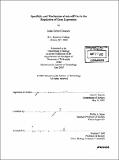| dc.contributor.advisor | Phillip A. Sharp. | en_US |
| dc.contributor.author | Doench, John Gerard | en_US |
| dc.contributor.other | Massachusetts Institute of Technology. Dept. of Biology. | en_US |
| dc.date.accessioned | 2006-02-02T18:56:41Z | |
| dc.date.available | 2006-02-02T18:56:41Z | |
| dc.date.copyright | 2005 | en_US |
| dc.date.issued | 2005 | en_US |
| dc.identifier.uri | http://hdl.handle.net/1721.1/31185 | |
| dc.description | Thesis (Ph. D.)--Massachusetts Institute of Technology, Dept. of Biology, 2005. | en_US |
| dc.description | Vita. | en_US |
| dc.description | Includes bibliographical references. | en_US |
| dc.description.abstract | Originally thought of as a molecular inferior to its nucleic acid cousin DNA, RNA has more recently been appreciated as an equal partner in biology, a molecule at the heart of many crucial cellular reactions and perhaps the first molecule of life itself. The discovery of RNA interference (RNAi) has further emphasized the importance of RNA-based processes in the regulation of gene expression. One arm of the RNAi response uses a large class of endogenous, small RNA species termed microRNAs (miRNAs). The establishment of a mammalian tissue culture system has allowed for investigation of both the mechanism and specificity of miRNA-directed translational repression. The term RNAi can be used to encompass a wide variety of gene silencing phenomena. The canonical RNAi pathway, as first described by Fire and colleagues in C. elegans and studied biochemically in Drosophila by Tuschl, Zamore, and colleagues, is a post-transcriptional mechanism of gene silencing, in which short, interfering RNAs (siRNAs) guide the cleavage of complementary mRNAs. Endogenous miRNAs are similar to siRNAs, and the two pathways, siRNA-directed mRNA cleavage and miRNA-directed translational repression, share common protein components yet lead to different outcomes. Our results indicate that the distinct outcome of these pathways is largely determined by the interaction of the small RNA species with its mRNA target. Additionally, variation in the number of miRNA binding sites shows that miRNAs can act synergistically to enhance repression activity. | en_US |
| dc.description.abstract | (cont.) Further experimentation into the specificity of miRNAs revealed that the miRNA does not simply basepair to its target mRNA but rather that regions of the miRNA contribute differently to translational repression activity. The 5' region of the miRNA, the first -8 nucleotides, is necessary and sufficient for target recognition. The 3' region can contribute significantly to activity, however, in cases where the 5' region has less-than-optimal complementarity. Multiple miRNAs can regulate a single mRNA, and the degree of translational repression is dependent on the expression level of both the miRNA and the mRNA. These results indicate that miRNAs are capable of regulating a substantial percentage of the genome and thus are integral factors in the control of gene expression. Finally, the observation that miRNAs can direct mRNA cleavage, albeit inefficiently, offers promise for finding endogenous miRNA targets and understanding the scope of miRNA-directed regulation of gene expression. | en_US |
| dc.description.statementofresponsibility | by John Gerard Doench. | en_US |
| dc.format.extent | 128, [2] leaves | en_US |
| dc.format.extent | 6605680 bytes | |
| dc.format.extent | 6622522 bytes | |
| dc.format.mimetype | application/pdf | |
| dc.format.mimetype | application/pdf | |
| dc.language.iso | eng | en_US |
| dc.publisher | Massachusetts Institute of Technology | en_US |
| dc.rights | M.I.T. theses are protected by copyright. They may be viewed from this source for any purpose, but reproduction or distribution in any format is prohibited without written permission. See provided URL for inquiries about permission. | en_US |
| dc.rights.uri | http://dspace.mit.edu/handle/1721.1/7582 | |
| dc.subject | Biology. | en_US |
| dc.title | Specificity and mechanism of microRNAs in the regulation of gene expression | en_US |
| dc.type | Thesis | en_US |
| dc.description.degree | Ph.D. | en_US |
| dc.contributor.department | Massachusetts Institute of Technology. Department of Biology | |
| dc.identifier.oclc | 61271235 | en_US |
